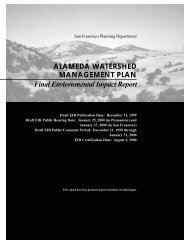Feasibility of Fish Passage at Alameda Creek Diversion Dam
Feasibility of Fish Passage at Alameda Creek Diversion Dam
Feasibility of Fish Passage at Alameda Creek Diversion Dam
Create successful ePaper yourself
Turn your PDF publications into a flip-book with our unique Google optimized e-Paper software.
7.0 Evalu<strong>at</strong>ion <strong>of</strong> the Biological Benefit <strong>of</strong> Two <strong>Passage</strong> Options2. The neg<strong>at</strong>ive effects <strong>of</strong> genetic drift and inbreeding are inversely proportional to popul<strong>at</strong>ion size.Thus, avoid managing for small popul<strong>at</strong>ion sizes.3. Management <strong>of</strong> wild popul<strong>at</strong>ions should be consistent with the history <strong>of</strong> their genetic p<strong>at</strong>ternsand processes. For example, historically isol<strong>at</strong>ed popul<strong>at</strong>ions should remain isol<strong>at</strong>ed unless otherconcerns dict<strong>at</strong>e th<strong>at</strong> gene flow must occur. Gene flow among historically connected popul<strong>at</strong>ionsshould continue <strong>at</strong> historical r<strong>at</strong>es, even if th<strong>at</strong> calls for assisted movement <strong>of</strong> individuals.Sufficient life-history diversity must exist to sustain a popul<strong>at</strong>ion through short-term environmentalperturb<strong>at</strong>ions and to provide for long-term evolutionary processes. The metrics and benchmarks forevalu<strong>at</strong>ing the diversity <strong>of</strong> a popul<strong>at</strong>ion should be evalu<strong>at</strong>ed over multiple gener<strong>at</strong>ions and include:1. The proportion <strong>of</strong> the diversity <strong>of</strong> a life-history trait or traits th<strong>at</strong> existed historically th<strong>at</strong> aremaintained in the existing popul<strong>at</strong>ion.2. The historic (n<strong>at</strong>ural) levels and origins <strong>of</strong> gene flow and genetic diversity rel<strong>at</strong>ive to the existingpopul<strong>at</strong>ion.3. The degree to which the existing popul<strong>at</strong>ion successfully uses available habit<strong>at</strong>s.4. The resilience <strong>of</strong> the existing popul<strong>at</strong>ion, and its ability to adapt to environmental fluctu<strong>at</strong>ions.Review <strong>of</strong> the fisheries liter<strong>at</strong>ure suggests th<strong>at</strong> a minimum <strong>of</strong> 100 breeding pairs <strong>of</strong> steelhead wouldensure sufficient genetic diversity for a genetically viable popul<strong>at</strong>ion (Langston and Zemlak, 1998)(see Section 6.2).A rainbow trout popul<strong>at</strong>ion currently exists in the Upper <strong>Alameda</strong> <strong>Creek</strong> Sub-W<strong>at</strong>ershed. Despiterecent isol<strong>at</strong>ion and some stocking, the genome <strong>of</strong> the historic steelhead popul<strong>at</strong>ion is expected to befairly well preserved in popul<strong>at</strong>ions isol<strong>at</strong>ed above ACDD. Limited genetic research conducted byNielsen (2003) suggests th<strong>at</strong> this popul<strong>at</strong>ion is closely rel<strong>at</strong>ed to Central California Coast steelheadand is likely composed primarily <strong>of</strong> the isol<strong>at</strong>ed, historic steelhead popul<strong>at</strong>ion. Although isol<strong>at</strong>ion <strong>of</strong>a small popul<strong>at</strong>ion can result in genetic drift and a reduction in genetic fitness (Campbell et al., 1999),Deiner et al. (2007) report th<strong>at</strong> construction <strong>of</strong> modern dams does not appear to have isol<strong>at</strong>edO. mykiss popul<strong>at</strong>ions for long enough to result in a loss <strong>of</strong> genetic diversity. The East Bay RegionalPark District reports th<strong>at</strong> priv<strong>at</strong>e property owners have intermittently planted rainbow trout below theOhlone section <strong>of</strong> upper <strong>Alameda</strong> <strong>Creek</strong> for 50 years prior to 1995 (Leidy et al., 2005), and the origin<strong>of</strong> these trout is unknown. Studies conducted in nearby Santa Clara Valley streams, however, suggestth<strong>at</strong> stocking has had little effect on the genetic composition <strong>of</strong> most San Francisco Estuary streamO. mykiss (Garza and Pearse, 2008). While steelhead access to the area has been blocked for manyyears, rainbow trout above ACDD likely retain most <strong>of</strong> the unique genetic character <strong>of</strong> n<strong>at</strong>ivesteelhead, despite prior stocking <strong>of</strong> h<strong>at</strong>chery rainbow trout.Facilit<strong>at</strong>ing fish passage could potentially introduce some out-<strong>of</strong>-basin genetic stocks to upper<strong>Alameda</strong> <strong>Creek</strong>. Considering the number <strong>of</strong> h<strong>at</strong>chery steelhead produced in the Central Valley, thereis a potential for some fish from the California Central Valley DPS to stray into <strong>Alameda</strong> <strong>Creek</strong>.However, maintaining a popul<strong>at</strong>ion <strong>of</strong> <strong>at</strong> least 100 breeding pairs <strong>of</strong> steelhead in the <strong>Alameda</strong> <strong>Creek</strong>W<strong>at</strong>ershed should allow for adequ<strong>at</strong>e within basin genetic diversity. Meffe and Carroll (1997) reportth<strong>at</strong> some level <strong>of</strong> gene flow among connected popul<strong>at</strong>ions is desirable. Some low level <strong>of</strong> strayingmay even increase the genetic diversity and fitness <strong>of</strong> the popul<strong>at</strong>ion. Facilit<strong>at</strong>ing gene flow amongO. mykiss isol<strong>at</strong>ed above ACDD and other O. mykiss popul<strong>at</strong>ions in the <strong>Alameda</strong> <strong>Creek</strong> W<strong>at</strong>ershed(through the provision <strong>of</strong> passage <strong>at</strong> ACDD and elsewhere in the w<strong>at</strong>ershed) may have a positiveACDD <strong>Passage</strong> June 2009 Page 7-3








